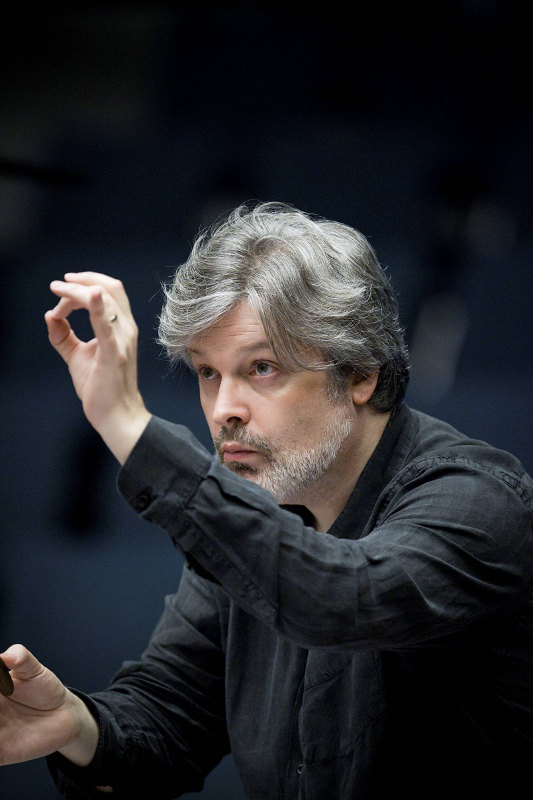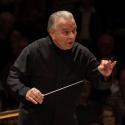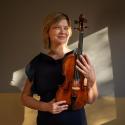The St Luke Passion I heard last night was my second sung Passion of the day. The first was in a parish church as a central part of the liturgy of the day on Good Friday: nothing too fancy, as befits an amateur choir, the words of St John as set by Victoria amid shining plainsong. We stood for the 30-odd minutes it took to sing, dropping briefly to our knees at the moment of the Lord's death. The St Luke Passion was on a different scale: in the majestic space of King's College Chapel, performed by full orchestra and three choirs, and packed out with the massed Great and Good of Cambridge, who spent its 75 minutes with bums firmly pressed into (none too comfortable) seats.
A way to understand the essential similarity of those two superficially different-sounding experiences – apart from the story itself of course – is through James MacMillan himself (pictured below right), who is not only a devout Roman Catholic, but like Victoria (and that other great Passion composer, J.S. Bach) a choirmaster, conducting Sunday services at St Columba's R.C. church in Maryhill, Glasgow. For all his St Luke Passion is festooned with orchestral effects of almost cinematic intensity (huge crescendi, lots of timpani), you can see its roots in the liturgical settings of the Passion story used in services on Good Friday.
 For one thing it requires no professional soloists. The part of Jesus is sung by a mass of trebles (from the Cardinal Vaughan Memorial School and Trinity Boys Choir), in unison or harmony, while the other parts are all taken by an SATB adult choir (the Britten Sinfonia singers). Polyphony is relatively rare, reserved for when the adult choir is a crowd at odd with itself, or worried (as when the disciples wonder which of them will betray Jesus). MacMillan's writing for the trebles in particular betrays his choral credentials: Jesus speaks in lyrical passages of great, swooping beauty of the kind that, in my experience, choristers find delicious to sing. As conductor he draws a wonderful sound from the boys, beautifully integrated (given how many of them there are) and packing a vibrantly human punch in the lower ranges alongside the necessary purity of the upper ranges, and diction as clear as possible in the resonant space of King's.
For one thing it requires no professional soloists. The part of Jesus is sung by a mass of trebles (from the Cardinal Vaughan Memorial School and Trinity Boys Choir), in unison or harmony, while the other parts are all taken by an SATB adult choir (the Britten Sinfonia singers). Polyphony is relatively rare, reserved for when the adult choir is a crowd at odd with itself, or worried (as when the disciples wonder which of them will betray Jesus). MacMillan's writing for the trebles in particular betrays his choral credentials: Jesus speaks in lyrical passages of great, swooping beauty of the kind that, in my experience, choristers find delicious to sing. As conductor he draws a wonderful sound from the boys, beautifully integrated (given how many of them there are) and packing a vibrantly human punch in the lower ranges alongside the necessary purity of the upper ranges, and diction as clear as possible in the resonant space of King's.
Unlike the Jesus of his St John Passion, MacMillan's Jesus here is a beacon of calm and serenity, seemingly unaffected by the storms of emotion which buffet him – and buffet is the word for the brass – and percussion-fuelled fortissimo pitches to which the orchestra, and sometimes organ, can rise. The chorus tends not to be quite as intense, even when they are angry or confused; in this Passion it seems everyone is at the mercy of elemental forces. Pilate, for example, speaks fairly calmly himself, but in the martial trumpets and timpani accompanying him we hear the throbbing agenda of Roman imperialism. The most chilling vocal moments are often rather quiet, as when the crowd begins to murmur "crucify him!", rolling the idea around as if someone at the back suggested it and they are only repeating it forward; the caprice of a crowd in a way more terrifying than its full-decibel demands. Despite all the movement in the music, which is constantly running up and down the octaves, as sharply contoured as the hill country of Galilee, MacMillan clearly hears underneath it all a constant note of sweetness, a musical form of the outpouring of divine love which Christians believe creates and sustains the universe. This note shines through whenever human confusion and wilfulness can be stripped away for a moment, and the human and the divine meet: when Jesus utters the words of institution at the Last Supper for example, and in fact in the voice of Jesus throughout (who is true God and true man, as the Nicene creed puts it). We also hear it from Mary in the glorious Magnificat, hymn meets dance meets love song, in the Annunciation scene which opens the work – an appropriate opening not only because the Incarnation is where the story starts, but because tradition holds that St Luke was an artist who painted the Virgin (pictured above left: Rogier van der Weyden's Saint Luke Painting the Virgin).
Despite all the movement in the music, which is constantly running up and down the octaves, as sharply contoured as the hill country of Galilee, MacMillan clearly hears underneath it all a constant note of sweetness, a musical form of the outpouring of divine love which Christians believe creates and sustains the universe. This note shines through whenever human confusion and wilfulness can be stripped away for a moment, and the human and the divine meet: when Jesus utters the words of institution at the Last Supper for example, and in fact in the voice of Jesus throughout (who is true God and true man, as the Nicene creed puts it). We also hear it from Mary in the glorious Magnificat, hymn meets dance meets love song, in the Annunciation scene which opens the work – an appropriate opening not only because the Incarnation is where the story starts, but because tradition holds that St Luke was an artist who painted the Virgin (pictured above left: Rogier van der Weyden's Saint Luke Painting the Virgin).
At the end, MacMillan gives us a short coda with the Ascension, that strange and wonderful episode in which the disciples are left gawping at the sky in unconscious imitation of the shepherds who did the same at the very beginning of Jesus's time on earth. The choir seems to direct the angels' question directly at us, the audience: "Men of Galilee, why do you stand staring into heaven?" We won't find Jesus there, but MacMillan shows us what the disciples too needed to learn: that they could listen for him in that note of transcendent sweetness underlying everything – rendered in earthly music as a single, impossibly long note held by the trebles.
It's in this sense of earthly music as a reflection of divine harmony that we find the similarities between MacMillan and Victoria, and I don't think it's fanciful of me to have heard in the ascension scene the clearest echoes of plainsong. Amid the orchestral earthquakes, wind and fire with which his St Luke Passion plays out, MacMillan (who is a great expert in plainsong) never loses the still, small voice of divine truth. Conducting himself, he makes his Passion, for all the trappings of a secular concert which surround it, into the act of worship and discipleship which he, like the painter St Luke, believes all artistic depictions of Christian truth must be.
- MacMillan conducts the Britten Sinfonia in his St Luke Passion at the Barbican on Easter Sunday













Add comment